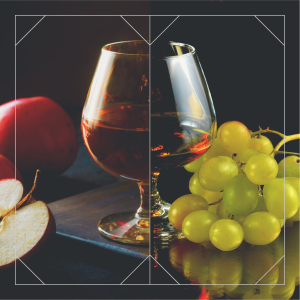Brandy vs. Cognac
Understanding the distinction between brandy and cognac is pivotal for both enthusiasts and casual consumers alike, as it unveils a rich tapestry of flavors, traditions, and craftsmanship. Delving into the realms of brandy and cognac not only enhances one’s appreciation for these refined spirits but also allows individuals to make informed choices when selecting and savoring these libations. So, let’s get into it!
What is Brandy?
Brandy isn’t just a fruity and subtly sweet drink; it’s not just a catchy song; it’s an entire category of spirit with many sub-varieties! The term “brandy” comes from the Dutch word brandewijn, which means “burnt wine.”
This fruit-based spirit is made all over the world. The brandy spirit category isn’t one to overlook, it’s a respectable libation. And like anything respectable, it has standards. In the United States, brandy is defined as a spirit produced from fermented fruit and cannot be distilled over 95% alcohol. Also, it must be produced to resemble the flavor of the base ingredient and bottled with a minimum of 40% alcohol.
Wow, who knew brandy had so many standards? You can easily divide brandy into two major categories, those based on grapes (basically distilled wine) and those based on non-grapefruits like plums, apples, cherries and/or dried fruits. Cognac falls under the grape-based.
What is Cognac?
Oftentimes, people will use brandy and cognac interchangeably. Depending on the context, they may not be wrong, but they may not be right either. All cognac is brandy, but not all brandy is cognac. It’s easy if you think of brandy as you would wine. Wine is the umbrella category, but there’s pinot noir, cabernet, chardonnay and so on and so on. Brandy is like that, an umbrella category with cognac falling under it.
Cognac has standards just like brandy does. In order for a brandy to be called cognac it must meet the requirements of the appellation d’origine contrôllée(AOC), and it must come from the Cognac region of France. It is such a delectable drink, that the French refer to it as from l’eau de vie, or “the water of life.” Cognac is, without a doubt, the world’s most famous brandy, which is why people use them interchangeably.
Different Types of Cognac
Since cognac is grape-based, it stands to reason that there are different types of cognac, such as there are grapes. We know, it can be a bit overwhelming. But with a little studiousness and interest, you’ll catch on in no time!
Cognac production allows three different varietals, including Ugni Blanc, Folle Blanche and Colombard. Ugni Blanc is by far the most widely planted grape varietal for eau-devie production, accounting for approximately 90% of acreage.
The Age Scale
Before we close things out, let’s briefly talk about the aging classifications:
-
- VS (very special)—must be aged at least two years
- VSOP (very superior old pale)—must be aged at least four years
- XO (extra-old)—must be aged at least ten years as of 2018
- XXO (extra-extra old)—cognacs that have been aged for 14 years or longer
Now you have plenty of information to hold your own in any future conversation about these two spirits! We’re finally at the fun part, where we highly recommend tasting brandy & cognac to see what all the hype is about.




